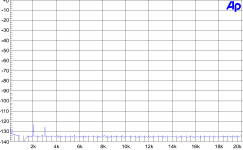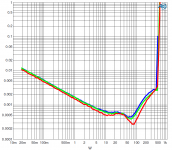and another loudspeaker with a high-frequency response with more peaks and dips than I've seen for quite a while---if they were narrower I'd suppose it was an electrostat.
you don't Have to place your electrostats parallel to and too close to a reflective wall
bwaslo "So, what kind of crossover distortion type things happen in class d? Things that make distortion go high as signal level decreases toward zero? If there are lots of such, as stated."
--Faires.
john curl "I agree that xover distortion is a misleading term in this case. However, it does add a lot of higher order distortion."
--Please point out to me this high order distorion cause i can't see it i will post two graphs.
1st Class D amp at 1Watt 8ohm fundamental surpressed 1kHz
2nd THD+N vs Power at 2ohm 20 kHz bandwidth B 100Hz G 1kHz R 6kHz
--Faires.
john curl "I agree that xover distortion is a misleading term in this case. However, it does add a lot of higher order distortion."
--Please point out to me this high order distorion cause i can't see it i will post two graphs.
1st Class D amp at 1Watt 8ohm fundamental surpressed 1kHz
2nd THD+N vs Power at 2ohm 20 kHz bandwidth B 100Hz G 1kHz R 6kHz
Attachments
This sounds very much like an urban myth! Nuvistors have metal cases and so the filaments would not be visible. I really doubt this happened; I have no doubt that the rumor (as indicated) got around.
No, wiring just the heaters up on tubes, but having the tubes actually do nothing has happened/is happening.
If it's not the nuvistor, then it may have been with another tube.
Maybe they just have to be warm to create the tube sound?
Member
Joined 2009
Paid Member
more likely they put them inside a gnf loop and lost all sense of their contribution to the sound
This sounds very much like an urban myth! Nuvistors have metal cases and so the filaments would not be visible. I really doubt this happened; I have no doubt that the rumor (as indicated) got around.
I put nothing past them, deal with it, the basic level of corruption in the audiophile biz is there in spades.
In my experience, those two qualities have nothing to do with a use of a feedback. The circuit does.... I have some concerns about GNFB, particularly imaging and 'engagement', aspects of sound quality which are almost impossible to measure....
Feedback is always good: there is a bunch of really badly designed circuits that sound bad, but only with feedback - without GNFB they wouldn't work at all. There are also good circuits which are slightly improved with use of a feedback (less distortion, lower Z_out, gain fixed in wider freq. region...). And there are very good circuits (usually very impractical) that don't need GNFB.
Feedback is a nature's own way, we have it all around us. Try showering without feedback - your water will be either too hot or too cold (you use feedback to adjust its tempertaure). It's true that one can build a showering system that will deliver perfectly tempered warm water on a press of a button but it's very likely that such a system will use the feedback.
As previously said, it's a tool. If GNFB was a fork i'd be carefull with it - one can poke his eyes out with it. On the other hand, eating with a fork is a lot cleaner and easier - and that's a fact.
Some may think that fork makes eating unnatural - and that's a belief.
No, wiring just the heaters up on tubes, but having the tubes actually do nothing has happened/is happening.
If it's not the nuvistor, then it may have been with another tube.
Maybe they just have to be warm to create the tube sound?
Seriously? No.
I put nothing past them, deal with it, the basic level of corruption in the audiophile biz is there in spades.
I know of no company that puts tubes in a product but only lights them up. This really is an urban myth.
Is GNFB perfect and what could be wrong with it? Many people subjectively find that there is "a fly in the ointment", speaking about GNFB story. But nobody can proove it strictly.
One skilled mathematician, who became interested in audio, tried to understand audible effects of GNFB for himself (I red his posts at forum). In the most general assumptions, he considered the feedback quadripole. The most common result is that a quadripole with any kind of feedback is always a generator. In the case of positive feedback - we know what the generator is. In the case of a negative - the generation fades exponentially. If one wants to minimize the generation decay process (settling) - try to achive maximum speed at feedback loop. Therefore, for amplifiers with GNFB it is good to have more than megahertz passband. For amplifiers without GNFB, it is not necessary.
Another finding was, "be careful with spectral analysis". "Better care of time locations of extremes of a signal as a function of time". "Linear distortions could harm more than nonlinear".
One skilled mathematician, who became interested in audio, tried to understand audible effects of GNFB for himself (I red his posts at forum). In the most general assumptions, he considered the feedback quadripole. The most common result is that a quadripole with any kind of feedback is always a generator. In the case of positive feedback - we know what the generator is. In the case of a negative - the generation fades exponentially. If one wants to minimize the generation decay process (settling) - try to achive maximum speed at feedback loop. Therefore, for amplifiers with GNFB it is good to have more than megahertz passband. For amplifiers without GNFB, it is not necessary.
Another finding was, "be careful with spectral analysis". "Better care of time locations of extremes of a signal as a function of time". "Linear distortions could harm more than nonlinear".
Last edited:
"Linear distortions", i.e. frequency response changes, are by far the most audible, after level changes.
Seriously? No.
I know of no company that puts tubes in a product but only lights them up. This really is an urban myth.
I just serviced an Audionote Kondo amplifier for a customer. The 5AR4 rectifier tube was bypassed by 2 silicon diodes soldered from anode to cathode on the tube socket. It came this way from the factory. The amp had never been opened prior to my doing service on it.
That is scandalous.I just serviced an Audionote Kondo amplifier for a customer. The 5AR4 rectifier tube was bypassed by 2 silicon diodes soldered from anode to cathode on the tube socket. It came this way from the factory. The amp had never been opened prior to my doing service on it.
I wonder if Bascom would have heard the difference.
Last edited:
GNFB reduces speaker cable induced HF EMI immunity. Put the output stage outside loop and make it class A with local feedback. Nothing is better.
I just serviced an Audionote Kondo amplifier for a customer. The 5AR4 rectifier tube was bypassed by 2 silicon diodes soldered from anode to cathode on the tube socket. It came this way from the factory. The amp had never been opened prior to my doing service on it.
Was the rectifier tube wired in? How do you know the providence?
I agree that would be scandalous.
Was the rectifier tube wired in? How do you know the providence?
I agree that would be scandalous.
The diodes were wired right across the tube socket. Pull the tube and B+ stays exactly the same. I guess that means the tube was wired in, but not operational. I had the original test papers from the amp which indicated the plate voltages on the 2A3 outputs. The measurements matched the stated voltage exactly. Pull the diodes and you got 10 volts less. The diodes were the same type as used elsewhere in the amp, as was the insulation on the leads, (both of which were very distinct and not commonly seen outside of Japanese products). There was no indication of any work having ever been done on the amp and the customer told me that the amp had never been serviced.
Last edited:
I have actually seen an audio circuit (which will not be identified) where a
tube was placed where it could be seen and illuminated from behind by an LED.
😎
tube was placed where it could be seen and illuminated from behind by an LED.
😎
Vlad, your math guy may be on to something important. We are constantly looking, but our test equipment screens out what we are looking for. The subjective results is virtually always: Higher bandwidth, or better yet, no global negative feedback.
I have actually seen an audio circuit (which will not be identified) where a
tube was placed where it could be seen and illuminated from behind by an LED.
😎
OMG, I'm seriously losing my religion here. I feel dirty.
I just serviced an Audionote Kondo amplifier for a customer. The 5AR4 rectifier tube was bypassed by 2 silicon diodes soldered from anode to cathode on the tube socket. It came this way from the factory. The amp had never been opened prior to my doing service on it.
The new Kondo amps are powered like that. Nothing scandalous even if the reasoning is not obvious.
I recall that too. Did they use an orange LED?I have actually seen an audio circuit (which will not be identified) where a
tube was placed where it could be seen and illuminated from behind by an LED.
😎
Can you elucidate?The new Kondo amps are powered like that. Nothing scandalous even if the reasoning is not obvious.
I suppose, looking at 5AR4 curves, that there would be a tiny contribution to the current from the tube.
- Home
- Amplifiers
- Solid State
- Global Feedback - A huge benefit for audio

